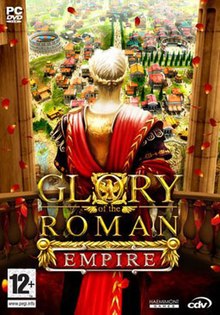Glory of the Roman Empire
This article needs additional citations for verification. (February 2010) |
| Glory of the Roman Empire Imperivm Civitas | |
|---|---|
 | |
| Developer(s) | Haemimont Games |
| Publisher(s) |
|
| Platform(s) | Windows |
| Release | |
| Genre(s) | City-Building Game |
| Mode(s) | Single player |
Glory of the Roman Empire is a 2006 city-building video game set during the age of the Roman Empire, developed by Haemimont Games. The game features a three-dimensional game engine and individual modeling of game character behaviors. The game was released in Spain and Italy in December 2006 by FX Interactive under the name Imperium Civitas. The difference in naming is explained by the popularity of Haemimont's previous games, Imperium I, II and III, which sold more than 1 million copies in these countries.
In the game, the player assumes the roles of city planner, governor, and military leader. Successful players will need planning skills, economic savvy, and—should those fail—military might. The glory of the Roman Empire will challenge gamers to grow a small village into a thriving community through trade with neighbors, while also expanding and defending its borders through more militaristic means. Players will need to focus on the physical and emotional health of the citizenry; as villagers age and mature under strong leadership, they contribute to the development of more advanced societies and larger cities.
A demo was released by Haemimont games on June 14, 2006,[1] and a sequel - Imperium Romanum - was released in 2008.
Scenarios[]
Glory of the Roman Empire:
Missions take place in Florentia (5 missions), Pompeii (1 mission), Syracusae (4 missions), Toletum (3 missions), Kartagena (3 missions), Massilia (2 missions), Mediolanum (2 missions), Lugdunum (2 missions), Londinium (3 missions), and Colonia Claudia (3 missions)
There are seven more scenarios that are sandboxes: Mountain Paradise, Desert, Highlander, Across the river, , , and Rome.
It also has a challenge mode where the player has to achieve random goals for 4 different cities.
Imperium Civitas: (Spanish and Italian edition)
There are two campaigns instead of one as in Glory of the Roman Empire. A military campaign and a peaceful campaign.
There are 12 freebuild cities: Burdigala, Colonia Agrippina, Syena, Andautonia, Roma, Geneva, Venetia, Tamiatis, Labacum, Antium, Salamantica, and Emerita Augusta
In the challenge mode the player can choose from Londinium, Lutetia, Colonia Agrippina, Burdigala, Lugdunum, Mediolanum, Andautonia, Tarraco, Carthago Nova, Tingis, Caralis, Carthago, Syracusae, Pompeii, and Roma.
Reception[]
| Aggregator | Score |
|---|---|
| Metacritic | 66/100[2] |
| Publication | Score |
|---|---|
| 1Up.com | C+[3] |
| Eurogamer | 6/10[4] |
| GameSpot | 5.6/10[5] |
| GameSpy | |
| GameZone | 7/10[7] |
| IGN | 7.6/10[8] |
| PALGN | 6/10[9] |
| PC Gamer (UK) | 70%[10] |
| PC Gamer (US) | 50%[11] |
| X-Play | |
| The Sydney Morning Herald |
The game received "average" reviews according to the review aggregation website Metacritic.[2]
See also[]
References[]
- ^ "Glory of the Roman Empire Single-Player Demo". GameSpot. Archived from the original on July 7, 2006. Retrieved October 6, 2017.
- ^ a b "Glory of the Roman Empire for PC Reviews". Metacritic. Retrieved October 6, 2017.
- ^ Luo, Di (August 30, 2006). "Glory of the Roman Empire". 1UP.com. Archived from the original on January 5, 2010. Retrieved October 6, 2017.
- ^ Clare, Oliver (June 26, 2006). "Glory of the Roman Empire". Eurogamer. Retrieved October 6, 2017.
- ^ Todd, Brett (July 13, 2006). "Glory of the Roman Empire Review". GameSpot. Retrieved October 6, 2017.
- ^ Abner, William (July 17, 2006). "GameSpy: Glory of the Roman Empire". GameSpy. Retrieved October 6, 2017.
- ^ Hollingshead, Anise (June 29, 2006). "Glory of the Roman Empire - PC - Review". GameZone. Archived from the original on October 5, 2008. Retrieved October 6, 2017.
- ^ Butts, Steve (June 22, 2006). "Glory of the Roman Empire". IGN. Retrieved October 6, 2017.
- ^ Jastrzab, Jeremy (July 18, 2006). "Glory of the Roman Empire Review". PALGN. Archived from the original on August 13, 2010. Retrieved October 6, 2017.
- ^ "Glory of the Roman Empire". PC Gamer UK. September 2006. p. 105.
- ^ "Glory of the Roman Empire". PC Gamer. October 2006. p. 71.
- ^ Bemis, Greg (August 23, 2006). "Glory of the Roman Empire". X-Play. Archived from the original on November 22, 2008. Retrieved October 6, 2017.
- ^ Fish, Eliot (July 22, 2006). "Glory of the Roman Empire". The Sydney Morning Herald. Retrieved October 6, 2017.
External links[]
- Official website
- Official website at Haemimont Games
- Official website at FX Interactive (in Spanish)
- Glory of the Roman Empire at MobyGames
- City-building games
- Windows games
- Windows-only games
- 2006 video games
- Video games set in the Roman Empire
- Multiplayer online games
- Video games developed in Bulgaria
- Video game sequels
- Video games set in antiquity